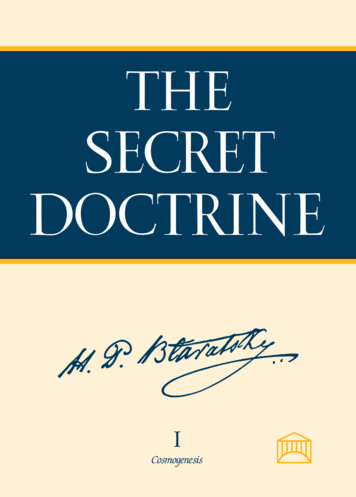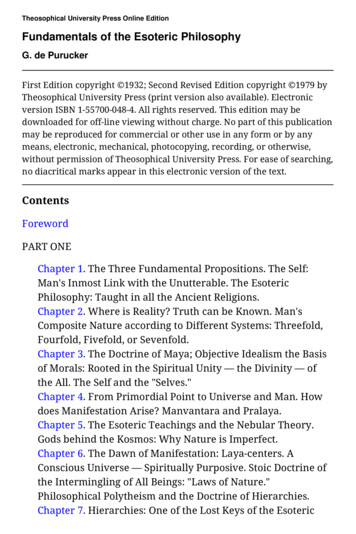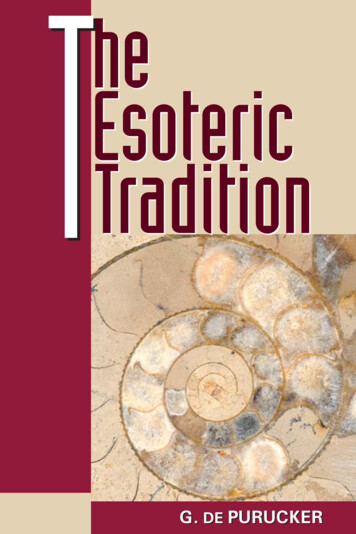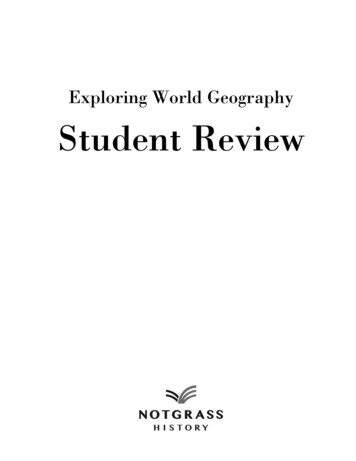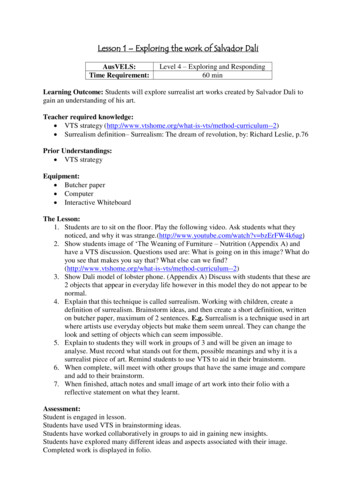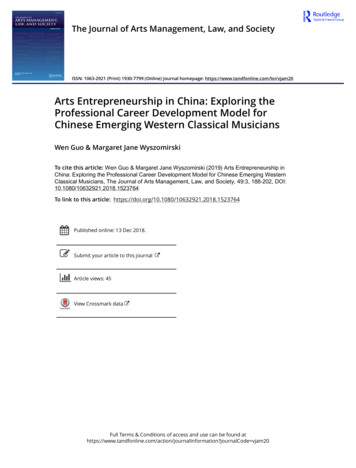
Transcription
ExploringTHEOSOPHY
ExploringTHEOSOPHYHA SUNRISE LIBRARY PUBLICATIONTHE THEOSOPHICAL SOCIETYPASADENA, CALIFORNIA
For further information on theosophy or afree catalog of publications, contactThe Theosophical Societypost office box cPasadena, California 91109-7107www.theosociety.org(626) 798-3378 tupress @ theosociety.orgCopyright 2007 by Theosophical University PressAll rights reserved.ISBN 978-1-5570-235-8 PDF eBookCover painting: “Prairie Path” by Patrice Hughes
NOTE: Titles below are links to chaptersContentsPrefaceiv1What Is Theosophy?12Man’s Search for Truth63Karma104Reflections on The Voice of the Silence145Spiritual Growth or Spiritual Behaviorism?196Infinite Imperfection237Reincarnation288The Universe: A Living Organism329Descents into Hades — Ascents into Heaven3510Inner and Outer Karma4011Spiritual Progress4412Occultism vs Psychic Powers4813The Perennial Philosophy5214The Path to the Heart of the Universe57
PrefaceThis collection of articles, condensed and editedfrom theosophical publications, is an invitation to inquirers to explore and enjoy the depth and beauty oftheosophy. The Theosophical Society is dedicated tomaking universal brotherhood better understood andmore deeply felt in human hearts. Its philosophy, drawnfrom the universal wisdom tradition of mankind, offers timeless principles that stimulate intuitive knowingand cast light on any question. These principles provide tools that can help students discover truth withinthemselves and unlock the mysteries of nature, fosteringaltruism and compassion for all beings.
1What Is Theosophy?There is a wisdom-tradition that once was universally known byevery people on the face of the globe, a common treasury of inspiration and truth from which the saviors and benefactors of mankind draw.Known variously in different eras as the perennial philosophy, the gnosis of Greek and early Christian thought, the esoteric tradition, or theMystery-teachings of the sanctuary — it is this god-wisdom that Jesusshared with the fisherfolk of Galilee; that Gautama imparted to ferryman and prince; and that Plato immortalized in letters and dialogues,in fable and myth. Today the modern presentation of this wisdom iscalled theosophy.What is theosophy? The word is of Greek origin, from theos, “god,”and sophia, “wisdom,” meaning “wisdom concerning divine matters.”As a term it has a venerable history, having been used by Neoplatonicand Christian writers from the 3rd to the 6th century ad, as well asby Qabbalists and Gnostics in an attempt to describe how the Onebecomes the many, how divinity or God manifests itself in a series ofemanations throughout all the kingdoms of nature. It was in use during medieval and renaissance times, Jakob Boehme being called theTeutonic Theosopher on account of his vision of man as microtheosand microcosmos.The word theosophia has also been linked to Ammonius Saccas ofAlexandria who, in the 3rd century ad, is said to have imparted to hispupils a theosophical system or school of thought in an attempt to fuseinto a universal synthesis the seemingly divergent elements of the archaic wisdom then current in that teeming metropolis. Of exemplary
/Exploring Theosophycharacter, he was called theodidaktos, “god-taught,” on account of thedivine inspirations he received. Ammonius exacted the strictest morality and although no record of his teachings or practices was made,providentially his pupil Plotinus later recorded for posterity the salientteachings of his master. Thus we have the Enneads or “Nine” books ofNeoplatonism, which have exerted a profound influence through succeeding centuries.Later in Europe, Qabbalists, Alchemists, the early Rosicrucians andFreemasons, Fire Philosophers, Theosophers, and others pursued theself-same purpose. Singly, and in secret associations, they held thatthe One, Divinity, the indefinable Principle, emanated forth from itself the entire universe, and that all beings and things within it willultimately return to that source. More specifically, they sought to injectinto the Christianity of their day the signal truth that mystical unionwith Divinity was everyone’s birthright because within each human being is a divine kernel.Clearly, then, the theosophic endeavor, its teaching and practice, isnot a new movement. It is ageless, rooted in the infinity of the past asfirmly as it will be rooted in the infinity of aeons to come. Theosophyhas no creed, no dogma, no set of beliefs that must be accepted, because truth is not something beyond or outside us, but in fact is within.Nonetheless, it comprises a coherent body of teachings about man andnature that have been expressed in various ways in the sacred traditionsof the world.The modern theosophical movement began in the last quarter ofthe nineteenth century — a timely intervention, for the precedingdecades had witnessed a radical upheaval in spiritual and intellectualthought. World consciousness was ripe for change: on the one hand,rampant materialism both in theology and science had a stranglehold onindependent inquiry and, on the other, many people hungry to believein the immortality of the soul were being led astray by the will-o’-thewisp of spiritualistic phenomena. A cosmic vision of man and his rolein the universe was sorely needed, one that would restore trust in divinelaw and offer meaningful explanation of the seemingly cruel injusticesof earthly existence.H. P. Blavatsky, a woman of extraordinary gifts powered by a fearless devotion to truth and to the eradication of the causes of human
What Is Theosophy?/ suffering, became the leading exponent for the modern theosophicalmovement. One of a long line of “transmitters” of the universal godwisdom, she cast into the thought-atmosphere of the world electrifyingideas, innovative ideas, ideas which would revolutionize the thinkingof mankind. Chief among these was that we are a oneness. She encouraged the investigation and study of the spiritual heritage of all peoples,in order to eradicate the conceit that any race or people is the “chosenone,” has the only true religion and the one and only God. Even acasual examination of other belief systems broadens our horizons.It is a thrilling experience to discern the same golden thread runningthrough every tradition, whether religious, philosophic, or so-calledprimitive; we feel at once a sympathy, an empathy, with all who holdor cherish these truths. This in itself makes for a oneness, a feeling ofunderstanding, a linkage of destiny.Every human being is a copy in miniature of what suns or stars are— living divinities housed in temples of matter. We have as vast apilgrimage behind us as ahead of us: a past filled with long cycles ofexperience through which the soul has matured to its present status,and a future of limitless possibilities during which we will evolve out ofhumanhood into the full glory of godhood. HPB makes no claim tohaving originated these teachings; rather, she was a transmitter in currentlanguage of “a select number of fragments” from the esoteric records.HPB invites us to consider a few “fundamental conceptions whichunderlie and pervade the entire system of thought” (The Secret Doctrine1:13) on which the sacred science of antiquity and the world’s religiousand philosophical schools are founded. Reduced to essentials, theseare:1) That there is an eternal, omnipresent, immutable Principle whichcannot be defined as it is “beyond the range and reach of thought,” yetfrom It all life emanates or flows forth. Theosophy has no name forthis Principle except to call it That — the infinite, the uncreate, therootless root, the cause without a cause. These phrases are merely aneffort to describe the indescribable, the infinity of infinities, the boundless essence of divinity which we cannot define. In short, it posits thatmarvelous primordial essence which Genesis calls the darkness on theface of the deep — that darkness which was sparked into light when the‘elohîm breathed on the waters of Space.
/Exploring Theosophy2) That universes like “manifesting stars” appear and disappear intidal flux and ebb, a rhythmic pulsation of spirit and matter, with everylife-spark in the cosmos, from stars to atoms, pursuing the same cyclicpattern. There is continual birth and death, appearance and disappearance, of these “sparks of Eternity” as the rhythm of life brings forthever new life forms for returning worlds: galaxies and suns, humanbeings, animals, plants, and minerals. All beings and things have theirbirth and death cycles, because birth and death are gateways of life.3) That all souls, being at their heart the same in essence as the“Universal Over-Soul,” are required to undergo the full cycle of imbodiments in material worlds in order to bring into active expression,by self-effort, their divine potentialities.Why does divinity manifest so many times and in so many differentforms? Every divine seed, every spark of God, every unit of life, mustgo through the great cycle of experience, from the most spiritual realmsto the most material, in order to gain firsthand knowledge of every condition of being. It must learn by becoming every form, i.e., by imbodying in them as it pursues its course through the arc of matter.Here’s a vision to lift the heart: to feel that every human being is anecessary part of the cosmic purpose is to give dignity to our strivings,to the urge to evolve. The reason for this grand “cycle of necessity” istwofold: whereas we start as unself-conscious god-sparks, by the timewe have experienced all there is to learn in every life form, not only shallwe have awakened into fuller awareness the multitudes of atomic liveswhich serve as our bodies on the various planes, but we ourselves shallhave become gods in our own right.When we grasp the intimate relationship of these three postulatesto ourselves, we come to see how all the other teachings flow forth fromthem; they are as keys to a larger understanding of reimbodiment, cycles,karma, what happens after death, the cause and relief of suffering, thenature of man and cosmos, the interplay of involution/evolution, andmore — all the while the awakening soul is pursuing the eternal quest.The theosophical philosophy is vast as the ocean: “unfathomable inits deepest parts, it gives the greatest minds their fullest scope, yet, shallow enough at its shores, it will not overwhelm the understanding of a
What Is Theosophy?/ child.” Even though its truths go deeply into cosmological intricacies,a beautiful simplicity runs through the whole: oneness is the golden key.We are our brothers, no matter what our racial, social, educational, orreligious background. And this affinity is not limited to the humankingdom: it takes in every atomic life that is evolving as we are — allwithin the webwork of hierarchies that compose this pulsating organism we call our universe. Assuredly our great error has been to regardourselves as discrete particles adrift in a hostile universe, rather than asgod-sparks struck from the central hearth of Divinity — as intrinsicallyone in essence as the flame of the candle is one with the stellar fires inthe core of our sun.Of course, acceptance of the principle of universal brotherhood isrelatively simple compared to living it. All of us have difficulty at timesliving harmoniously with ourselves, let alone with others. Perhaps afirst step would be to accept ourselves, to be friends with the whole ofour nature, recognizing that when we do so we are accepting our lowertendencies along with our higher potentialities. In this acceptance weautomatically are accepting others, their frailties as well as their grandeur. This is brotherhood in action, for it dispels those subtle blockagesthat bar us from feeling we all are units of one human life-wave.Already the theme of our oneness with nature has revolutionizedpresent-day thinking and lifestyles. Once again we are beginning to seeourselves as participants in an ecosystem of cosmic dimension. We arediscovering that we, the observers, measurably affect not only the objectwe are observing but the entire complement of evolving entities. Bestof all, we are realizing, though not sufficiently as yet, that we are onehumanity, and that what you or I do to help another benefits all, strik- ing a resonant chord in the ongoing symphony that together we arecomposing. Though the burden of our inhumanities is indeed heavy,the universe must rejoice over the slightest movement of compassion inthe soul of even a single human being. William Q. Judge, The Ocean of Theosophy, p.1.
2Man’s Search for TruthTruth is elusive. Scholars delving into the past; scientists seeking toexplain the universe, the atom, the butterfly; neighbors conversing overthe back fence endeavor to see things as they truly are. This phrase,things as they are, is a potent one. We might tentatively adopt it as adefinition of truth: things-as-they-are as distinct from what they appearto be to our senses and limited minds.Our search for truth goes hand in hand with our ability to comprehend it. Opening our natures to be more, to understand more profoundly and compassionately, is part of the process. Those who arelarger of heart and mind can see further beneath appearances; they arenot bound by our narrow horizons.What prevents us from seeing things as they truly are? There isof course the illusion of appearances, called mãyã in the Orient. Innumerable examples confirm that appearances are deceiving; also ourpreconceived ideas stand in our way. We see only what we are preparedto see. We approach reality with glasses already tinted. Each era andeach culture tints its glasses differently. We demand that reality showitself to us as we think it should be, instead of the way it is. Our humannatures are not open and flexible enough; our minds are not free ofpreconceptions, nor our intuitions sufficiently alive to penetrate to theheart of things. As yet we are only partly evolved or awakened.Everyone has a kind of longing to know how things really are. “Howare you?” we ask a friend. We wish to know. We have ties with thisperson. His welfare and ours are connected. If he is not fit, we will feelourselves somehow diminished. What is the truth of him? He visits a
Man’s Search for Truth/ doctor, let us say, and is scanned and tested in a multitude of ways andpronounced in good health. What do all these facts tell us about him?Practically nothing. This is because the most important aspects of ahuman being are invisible. It is impossible to discover the actual personfrom appearances only, for he is a great deal more. Should we not applythe same reasoning to other areas? To birds and flowers, to the windand the rain, to comets and suns? Do not these things have an inwardreality behind the outward seeming? The poets feel this keenly. Thatis what poetry is all about.What I am trying to say is that we should leave ourselves as open, assusceptible to the inside truth as we are alert to observe and classify visible phenomena. To get the feel of things is often more important thanto analyze them, to measure and to weigh them. The quest for truth isnot an intellectual game. It is a looking within and a looking without.Nothing we see outside would mean anything unless it sparked something in us. How may we know beauty, grandeur, courage, unless thesequalities are within us to respond? In this sense, truth lives in us as adivine potential or, as Browning phrased it: “There is an inmost centrein us all, / Where truth abides in fullness.” From this quiet center comegleams and insights. The mystic or sage, artist or poet, expresses theseglimpses, and these have the power to awaken us.Truth resides in the heart of the heart of all beings, great and small.Some have unfolded more understanding of this truth. We are at thehuman stage of comprehension and self-expression. Birds are birds byreason of the same process. Gods are gods because they have unfoldedthe godlike. Hence truth-seeking has throughout the ages been linkedwith the idea of the path, the path of unfolding latent capacities. We areon this path leading to our flowering as human beings, whether or notwe realize it. And when we extend our view to encompass many livesor reincarnations we realize we have the time scale needed for everyoneto develop his higher potential. Those who have successfully accomplished this are the great teachers and philosophers: Christ, Buddha,Zoroaster, and a host of others, among them Plato and Pythagoras.Truth needs no outside force, for it persuades by its innate veracity.What kind of truth are we looking for? Religious, philosophic, or scientific? It is sometimes believed that these three are incompatible. Thisis not the case, however, for they are facets of the one truth — in man, in
/Exploring Theosophynature, in the cosmos. One person may approach reality from the spiritual point of view, another from the intellectual, a third from observingthe physical world with all its marvels and beauty. They could no morecontradict one another than the fact that I am a soul contradicts that Ialso have a body. Properly understood, the wisdom of each branch oflearning can only augment and extend the others, for each approachesthe same reality from a different angle.The great universe surrounds us on every side. It is our parent; wewere born of and from it. All that we are in the small, it must be on animmensely grander scale. We have only to step outside some night whenthe wise old stars are shining. Looking up into the immeasurable heavenssomething stirs within us, a feeling beyond the reaches of the finite mind.The soul yearns for an immensity it cannot grasp: deep calling to deep.According to the old traditions, our universe has a certain structureand operates in certain ways. It was born as we were born, lives its lifeand, like us, will one day die, rest. And sometime in the far, far futureit will be reborn. Religion, science, and philosophy seek to explain itand our relation to it. They search for the truth of it, approaching theproblem from their respective points of view, using their own terms,but there can be no final statement of truth. To the degree that an individual penetrates the mystery and reports his findings honestly, to thatdegree will his conclusions coincide with the equally honest findings ofothers, whether these be metaphysical or physical. But when the spiritof free inquiry has fled an organization designed to house it, what is leftare the empty ceremonial, the sterile, cerebral platitudes.We are all learners sharing with one another, and we would learn verylittle if we consulted only those who hold our point of view. Often moreis to be gleaned from those whose thoughts seem to differ from ours.But sometimes the barrier of semantics separates those whose beliefs,actually, may be very close. If one were to search for similarities ratherthan differences, he would find agreement in the broad area of generalprinciples. What is the difference between the karma of the East and thesowing and reaping of the New Testament? Truth is one, it cannot beotherwise, but the paths to it are as numerous as are the searchers.What this means is that all efforts through the ages to explain thecosmos are based, indeed must be based, on certain principles and experiences common to all, including the mystical and the poetical.
Man’s Search for Truth/ One way to keep truth alive and growing in our hearts is to reexpressit constantly. Otherwise we shall become worshipers of commas andsemicolons, and truth will lie buried in unthinking mantras endlesslyrepeated. In the long reach of the moving centuries the living spirit oftruth becomes entombed in its very institutions. Dogmas grow in theminds of men. Once symbols of the living message, they sooner or laterbecome like shells found on some lonely beach, often beautiful, but astructure from which the life and meaning have fled. The answer to oursearch for truth does not lie in institutions, it lies in ourselves.The spirit of the most high is in all things. In the wind movingagainst our faces, in the sparrow and the daisy and the pebble, in thosewho suffer and those who are glad, in the beautiful and in the ugly, andin the ugly made beautiful by the spirit within. The wisest of mankindhave pictured man as a child of the cosmos. They saw the worlds thatbestrew the fields of space as animated by cosmic divinities in whom welive and move and have our being; that the life that animates universesbreathes in us also, and that we too are the beneficiaries of its serenelaws.Truth is out there and in here. It is the way things are in us and inour world. We are urged to search for it by forces within ourselves, soulqualities. How much will come to us through suffering? How muchthrough joyful realization? How much in the day-to-day giving of ourbest to the calls of duty? How much through our love for companions,known and unknown, who travel the road of life with us? Electricity was in the world from the beginning. How many million men observed its effects before one discovered it? Gold was in the world from the beginning. How many men pass where it lies hidden, until one digs and finds it! Wisdomwas in the universe from the beginning, but only those whose minds are open to itcan deduce the truth from what they see.
3KarmaHuman life is full of inequities: differences in material conditions,opportunities, and abilities, as well as natural or man-made disasterswhich bring suffering to hundreds of people without any apparent causeon the part of the victims. Is there justice in such a world? Can thecauses behind these events be found?Certainly we do not live in a random universe. Physical cause andeffect forms the basis of both scientific knowledge and day-to-day decisions. But we often fail to realize that the physical world is but the effector outermost shell of a cosmos composed almost entirely of grades ofconsciousness and substance not readily perceived by our senses. It ismade up of the bodies of living organisms, forming a limitless web ofinterconnected lives acting and reacting on each other.This universal action and reaction, or cause and consequence, iscalled karma, a Sanskrit word meaning “action.” Although some traditions present this as the personal will of a divine being, karma isuniversal and impersonal, an inherent attribute of nature. Every act,thought, or feeling is an energy which has an impact on the universe.The universe then reacts as a matter of course, and sooner or later theforce rebounds upon its source. Activities in harmony with natural patterns maintain and reinforce that harmony, which then is reflected backonto the generator; activities in conflict with the patterns of naturecreate disharmony, which is also reflected back on the initiator. Calling it punishment or reward is simply projecting our own feelings ontothe natural process by which balance is restored after individuals, usingtheir will, create causes.Because we do not see the immediate cause of our character, circum
Karma/11stances, associations, joys, and sufferings, we are apt to explain them aschance, luck, fortune, or divine will. The inequal ities in human life,however, are caused by the people involved, individually and as groups.This goes unrecognized, especially if we view ourselves as completelynew at birth, instead of as the expression of a spiritual conscious nesscenter with a past history as long as that of the universe itself.Beings who have reached the human stage have lived many lives onearth as a human being. They have built up, from within themselvesand by reacting to circumstances, particular characteristics, and havereinforced certain abilities and lacks. Further, each individual, throughcontact with others, has set in motion causes which attract him to particular groups of people in order to experience the effects. Each humanbeing is born with many tendencies and relationships awaiting the opportunity for expression and modification in a new set of circumstances.Considering the many causes we set in motion even in one lifetime, wecannot wonder at the variety of conditions in the world.Why Don’t We Remember the Causes?The reason we aren’t consciously aware of many causes we have setin motion lies in our complex, compound structure. During life weidentify almost completely with our personality and body, but this personality or everyday psychological self does not survive death intact anymore than our body does. When the spiritual aspects withdraw fromour psychological “body” after death, the forces holding it together dissipate, and it disintegrates into psychological “atoms” which circulatethrough nature just as the physical atoms of our body do after death.When the time comes for rebirth, most of this mental-emotional substance is gathered together again to form the new personality, and therecombined elements have no remembrance of the personality theyhelped form before. Nevertheless, because these atoms bear the im pressof qualities and tendencies stamped upon them in the last imbodiment,the “new” personality is the direct result and serial continuation of theprevious one. We are affected by this karma that we do not fully understand or remember because it is literally part of us, formed by us.Nevertheless we are more than psychomental beings. Our spiritualaspects are enduring and retain the record of our past. If we centeredour consciousness on these levels, we could know our past lives — though
12 /Exploring Theosophywe might find this a very sobering experience. As our everyday consciousness becomes more universal, it gradually grows toward its spiritualparent, until the time comes when we pass consciously through death andreimbodiment and are able to know the causes that form our life.Is Karma Fatalism?If everything has a cause and nothing results from chance, somepeople conclude that we must be trapped by the past into a predetermined, inescapable fate. Such a view overlooks the idea that we are notcreatures only of matter or mind, but fundamentally identical in ourinmost reaches with cosmic divinity. Every entity in nature has freewill, even though its freedom is limited by its level of evolution and itsrelations with other entities. Yet these limitations do not mean we donot express our free will.Our habits of thought, feeling, and action are powerful forces, andit is easy to drift along the route of least resistance. But if our desire and commitment are strong enough, we can change. While wemust inevitably deal with the consequences of our actions, we need notbe controlled by them. New karmic effects arise constantly from ourreactions, motives, and attitudes, so that at every moment we are a newself-created entity. The personality which receives the effects of pastkarma may be quite changed from the one which originally made it, justas the mature person is usually different from what he was as a teenager,though he is the same individual and must deal with the consequencesof the teenager’s decisions. His present perspective may allow him tomeet creatively even unfortunate effects of his past, trans muting something potentially negative into an opportunity to learn and grow.By generating causes of a more harmonious quality we can mitigateand perhaps find positive aspects to much of the former inharmoniouseffects we have made, while planting seeds of a new kind for the future.Thus, karma allows us to choose and mold our destiny, giving us theopportunity to guide our life by governing ourselves and how we letcircumstances affect us.Karma and CompassionSometimes karma is misinterpreted as a rationalization for callousness and for maintaining a status quo of suffering and injustice, indi-
Karma/13vidually or socially. Such reasoning ignores the fact that it is not only aperson’s karma to experience trying situations, but also to have othersthere in a position to help. By remaining aloof from another, we createself- limiting karma in ourselves. As parts of one organic unity, identical in essence with each and every other part, it is our responsibility toassist others to the best of our ability. Compassion and fellow-feelingfor all is a prime pathway of growth and the expression of what is trulyand nobly human.The key to understanding the present lies in recognizing that everything has a cause and will have an effect, for the universe and allin it have been formed by their past activities. We each have shapedourselves through innumerable lives into exactly who we are at present,and by our current thoughts, actions, and desires are forming our futureself. Our reactions to those around us set up a pattern of causes whichmust be worked out in future relationships with those individuals. Andjust as we are the great storehouse of our past karma, so is every otherentity in nature its own karma. As human beings we are part of greaterentities — such as the earth and solar system — which also create karmathat affects humanity just as our actions affect the smaller lives whichcompose our bodies.There is interaction and reaction among all things, for the universeis a complete unity, a single living organism, rather than a collectionof superficially related parts as it sometimes appears to be. Each partaffects the whole at every instant, and is affected by it, and these interrelations make the universe function as it does. Our lives have an impacton everything within and around us; what we choose to think and doand feel is not limited in its effect only to ourselves or to those we know.If we can see beyond the narrow, self-centered aspects of ourselves andlive in accordance with the wider interests of the myriad beings whichsurround us, we will become a positive influence of planetary extent,creating karma which will be a present and future benediction. Fear nothing, for every renewed effort raises all former failures into lessons, allsins into experiences. In
The Theosophical Society is dedicated to making universal brotherhood better understood and more deeply felt in human hearts. Its philosophy, drawn from the universal wisdom tradition of mankind, of-fers timeless principles that stimulate intuitive knowing and cast light on any question. These principles pro-

